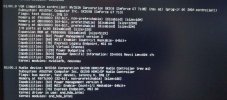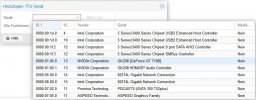1: lo: <LOOPBACK,UP,LOWER_UP> mtu 65536 qdisc noqueue state UNKNOWN mode DEFAULT group default qlen 1000
link/loopback 00:00:00:00:00:00 brd 00:00:00:00:00:00
2: enp4s0: <BROADCAST,MULTICAST,UP,LOWER_UP> mtu 1500 qdisc pfifo_fast master vmbr0 state UP mode DEFAULT group default qlen 1000
link/ether bc:ae:c5:29:27:55 brd ff:ff:ff:ff:ff:ff
3: enp5s0: <BROADCAST,MULTICAST,UP,LOWER_UP> mtu 1500 qdisc pfifo_fast master vmbr1 state UP mode DEFAULT group default qlen 1000
link/ether bc:ae:c5:29:26:ca brd ff:ff:ff:ff:ff:ff
4: vmbr0: <BROADCAST,MULTICAST,UP,LOWER_UP> mtu 1500 qdisc noqueue state UP mode DEFAULT group default qlen 1000
link/ether bc:ae:c5:29:27:55 brd ff:ff:ff:ff:ff:ff
5: vmbr1: <BROADCAST,MULTICAST,UP,LOWER_UP> mtu 1500 qdisc noqueue state UP mode DEFAULT group default qlen 1000
link/ether bc:ae:c5:29:26:ca brd ff:ff:ff:ff:ff:ff
6: veth133i0@if2: <BROADCAST,MULTICAST,UP,LOWER_UP> mtu 1500 qdisc noqueue master fwbr133i0 state UP mode DEFAULT group default qlen 1000
link/ether fe:73:51:2b:67:51 brd ff:ff:ff:ff:ff:ff link-netnsid 0
7: fwbr133i0: <BROADCAST,MULTICAST,UP,LOWER_UP> mtu 1500 qdisc noqueue state UP mode DEFAULT group default qlen 1000
link/ether 62:5b:52:ae:4b:d8 brd ff:ff:ff:ff:ff:ff
8: fwpr133p0@fwln133i0: <BROADCAST,MULTICAST,UP,LOWER_UP> mtu 1500 qdisc noqueue master vmbr0 state UP mode DEFAULT group default qlen 1000
link/ether 1a:75:2a:6a:08:72 brd ff:ff:ff:ff:ff:ff
9: fwln133i0@fwpr133p0: <BROADCAST,MULTICAST,UP,LOWER_UP> mtu 1500 qdisc noqueue master fwbr133i0 state UP mode DEFAULT group default qlen 1000
link/ether 62:5b:52:ae:4b:d8 brd ff:ff:ff:ff:ff:ff
10: veth139i0@if2: <BROADCAST,MULTICAST,UP,LOWER_UP> mtu 1500 qdisc noqueue master fwbr139i0 state UP mode DEFAULT group default qlen 1000
link/ether fe:c7:45:7b:ca:0e brd ff:ff:ff:ff:ff:ff link-netnsid 1
11: fwbr139i0: <BROADCAST,MULTICAST,UP,LOWER_UP> mtu 1500 qdisc noqueue state UP mode DEFAULT group default qlen 1000
link/ether ce:5f:5a:fe:6f:18 brd ff:ff:ff:ff:ff:ff
12: fwpr139p0@fwln139i0: <BROADCAST,MULTICAST,UP,LOWER_UP> mtu 1500 qdisc noqueue master vmbr0 state UP mode DEFAULT group default qlen 1000
link/ether 5a:d0:ca:d7:6a:f7 brd ff:ff:ff:ff:ff:ff
13: fwln139i0@fwpr139p0: <BROADCAST,MULTICAST,UP,LOWER_UP> mtu 1500 qdisc noqueue master fwbr139i0 state UP mode DEFAULT group default qlen 1000
link/ether ce:5f:5a:fe:6f:18 brd ff:ff:ff:ff:ff:ff
18: veth104i0@if2: <BROADCAST,MULTICAST,UP,LOWER_UP> mtu 1500 qdisc noqueue master fwbr104i0 state UP mode DEFAULT group default qlen 1000
link/ether fe:8d:41:25:64:63 brd ff:ff:ff:ff:ff:ff link-netnsid 3
19: fwbr104i0: <BROADCAST,MULTICAST,UP,LOWER_UP> mtu 1500 qdisc noqueue state UP mode DEFAULT group default qlen 1000
link/ether ca:06:26:42:0e:cf brd ff:ff:ff:ff:ff:ff
20: fwpr104p0@fwln104i0: <BROADCAST,MULTICAST,UP,LOWER_UP> mtu 1500 qdisc noqueue master vmbr0 state UP mode DEFAULT group default qlen 1000
link/ether 22:7b:58:e8:35:58 brd ff:ff:ff:ff:ff:ff
21: fwln104i0@fwpr104p0: <BROADCAST,MULTICAST,UP,LOWER_UP> mtu 1500 qdisc noqueue master fwbr104i0 state UP mode DEFAULT group default qlen 1000
link/ether ca:06:26:42:0e:cf brd ff:ff:ff:ff:ff:ff
22: veth111i0@if2: <BROADCAST,MULTICAST,UP,LOWER_UP> mtu 1500 qdisc noqueue master fwbr111i0 state UP mode DEFAULT group default qlen 1000
link/ether fe:66:13:6f:f6:c5 brd ff:ff:ff:ff:ff:ff link-netnsid 4
23: fwbr111i0: <BROADCAST,MULTICAST,UP,LOWER_UP> mtu 1500 qdisc noqueue state UP mode DEFAULT group default qlen 1000
link/ether 7e:01:a4:66:51:e7 brd ff:ff:ff:ff:ff:ff
24: fwpr111p0@fwln111i0: <BROADCAST,MULTICAST,UP,LOWER_UP> mtu 1500 qdisc noqueue master vmbr0 state UP mode DEFAULT group default qlen 1000
link/ether c6:cc:3d:f6:f0:4e brd ff:ff:ff:ff:ff:ff
25: fwln111i0@fwpr111p0: <BROADCAST,MULTICAST,UP,LOWER_UP> mtu 1500 qdisc noqueue master fwbr111i0 state UP mode DEFAULT group default qlen 1000
link/ether 7e:01:a4:66:51:e7 brd ff:ff:ff:ff:ff:ff
26: veth102i0@if2: <BROADCAST,MULTICAST,UP,LOWER_UP> mtu 1500 qdisc noqueue master fwbr102i0 state UP mode DEFAULT group default qlen 1000
link/ether fe:f9:a9:05:a4:e2 brd ff:ff:ff:ff:ff:ff link-netnsid 5
27: fwbr102i0: <BROADCAST,MULTICAST,UP,LOWER_UP> mtu 1500 qdisc noqueue state UP mode DEFAULT group default qlen 1000
link/ether 9e:ac:c8:59:24:e0 brd ff:ff:ff:ff:ff:ff
28: fwpr102p0@fwln102i0: <BROADCAST,MULTICAST,UP,LOWER_UP> mtu 1500 qdisc noqueue master vmbr0 state UP mode DEFAULT group default qlen 1000
link/ether 66:3a:da:34:0b:e2 brd ff:ff:ff:ff:ff:ff
29: fwln102i0@fwpr102p0: <BROADCAST,MULTICAST,UP,LOWER_UP> mtu 1500 qdisc noqueue master fwbr102i0 state UP mode DEFAULT group default qlen 1000
link/ether 9e:ac:c8:59:24:e0 brd ff:ff:ff:ff:ff:ff
30: veth115i0@if2: <BROADCAST,MULTICAST,UP,LOWER_UP> mtu 1500 qdisc noqueue master fwbr115i0 state UP mode DEFAULT group default qlen 1000
link/ether fe:2a:96:43:f7:6e brd ff:ff:ff:ff:ff:ff link-netnsid 6
31: fwbr115i0: <BROADCAST,MULTICAST,UP,LOWER_UP> mtu 1500 qdisc noqueue state UP mode DEFAULT group default qlen 1000
link/ether 9a:43:67:64:35:25 brd ff:ff:ff:ff:ff:ff
32: fwpr115p0@fwln115i0: <BROADCAST,MULTICAST,UP,LOWER_UP> mtu 1500 qdisc noqueue master vmbr0 state UP mode DEFAULT group default qlen 1000
link/ether 5e:d0:57:7a:f6:1a brd ff:ff:ff:ff:ff:ff
33: fwln115i0@fwpr115p0: <BROADCAST,MULTICAST,UP,LOWER_UP> mtu 1500 qdisc noqueue master fwbr115i0 state UP mode DEFAULT group default qlen 1000
link/ether 9a:43:67:64:35:25 brd ff:ff:ff:ff:ff:ff
46: veth106i0@if2: <BROADCAST,MULTICAST,UP,LOWER_UP> mtu 1500 qdisc noqueue master fwbr106i0 state UP mode DEFAULT group default qlen 1000
link/ether fe:cf:92:c9:ef:9d brd ff:ff:ff:ff:ff:ff link-netnsid 7
47: fwbr106i0: <BROADCAST,MULTICAST,UP,LOWER_UP> mtu 1500 qdisc noqueue state UP mode DEFAULT group default qlen 1000
link/ether c2:e2:4f:6a:fe:01 brd ff:ff:ff:ff:ff:ff
48: fwpr106p0@fwln106i0: <BROADCAST,MULTICAST,UP,LOWER_UP> mtu 1500 qdisc noqueue master vmbr0 state UP mode DEFAULT group default qlen 1000
link/ether de:38:67:9e:85:ac brd ff:ff:ff:ff:ff:ff
49: fwln106i0@fwpr106p0: <BROADCAST,MULTICAST,UP,LOWER_UP> mtu 1500 qdisc noqueue master fwbr106i0 state UP mode DEFAULT group default qlen 1000
link/ether c2:e2:4f:6a:fe:01 brd ff:ff:ff:ff:ff:ff
50: veth101i0@if2: <BROADCAST,MULTICAST,UP,LOWER_UP> mtu 1500 qdisc noqueue master fwbr101i0 state UP mode DEFAULT group default qlen 1000
link/ether fe:2e:3d:d8:ea:2a brd ff:ff:ff:ff:ff:ff link-netnsid 2
51: fwbr101i0: <BROADCAST,MULTICAST,UP,LOWER_UP> mtu 1500 qdisc noqueue state UP mode DEFAULT group default qlen 1000
link/ether c6:10:68:af:30:6d brd ff:ff:ff:ff:ff:ff
52: fwpr101p0@fwln101i0: <BROADCAST,MULTICAST,UP,LOWER_UP> mtu 1500 qdisc noqueue master vmbr0 state UP mode DEFAULT group default qlen 1000
link/ether 56:3a:00:de:f1:9b brd ff:ff:ff:ff:ff:ff
53: fwln101i0@fwpr101p0: <BROADCAST,MULTICAST,UP,LOWER_UP> mtu 1500 qdisc noqueue master fwbr101i0 state UP mode DEFAULT group default qlen 1000
link/ether c6:10:68:af:30:6d brd ff:ff:ff:ff:ff:ff
58: tap105i0: <BROADCAST,MULTICAST,PROMISC,UP,LOWER_UP> mtu 1500 qdisc pfifo_fast master fwbr105i0 state UNKNOWN mode DEFAULT group default qlen 1000
link/ether c2:5c:26:b6:29:36 brd ff:ff:ff:ff:ff:ff
59: fwbr105i0: <BROADCAST,MULTICAST,UP,LOWER_UP> mtu 1500 qdisc noqueue state UP mode DEFAULT group default qlen 1000
link/ether c6:c4:e3:eb:a3:37 brd ff:ff:ff:ff:ff:ff
60: fwpr105p0@fwln105i0: <BROADCAST,MULTICAST,UP,LOWER_UP> mtu 1500 qdisc noqueue master vmbr0 state UP mode DEFAULT group default qlen 1000
link/ether 76:d4:73:af:11:1b brd ff:ff:ff:ff:ff:ff
61: fwln105i0@fwpr105p0: <BROADCAST,MULTICAST,UP,LOWER_UP> mtu 1500 qdisc noqueue master fwbr105i0 state UP mode DEFAULT group default qlen 1000
link/ether c6:c4:e3:eb:a3:37 brd ff:ff:ff:ff:ff:ff
70: veth107i0@if2: <BROADCAST,MULTICAST,UP,LOWER_UP> mtu 1500 qdisc noqueue master fwbr107i0 state UP mode DEFAULT group default qlen 1000
link/ether fe:1a:26:2b:b0:69 brd ff:ff:ff:ff:ff:ff link-netnsid 8
71: fwbr107i0: <BROADCAST,MULTICAST,UP,LOWER_UP> mtu 1500 qdisc noqueue state UP mode DEFAULT group default qlen 1000
link/ether de:53:89:b7:3a:be brd ff:ff:ff:ff:ff:ff
72: fwpr107p0@fwln107i0: <BROADCAST,MULTICAST,UP,LOWER_UP> mtu 1500 qdisc noqueue master vmbr0 state UP mode DEFAULT group default qlen 1000
link/ether 86:65:04:08:70:be brd ff:ff:ff:ff:ff:ff
73: fwln107i0@fwpr107p0: <BROADCAST,MULTICAST,UP,LOWER_UP> mtu 1500 qdisc noqueue master fwbr107i0 state UP mode DEFAULT group default qlen 1000
link/ether de:53:89:b7:3a:be brd ff:ff:ff:ff:ff:ff
 ff"
ff"







